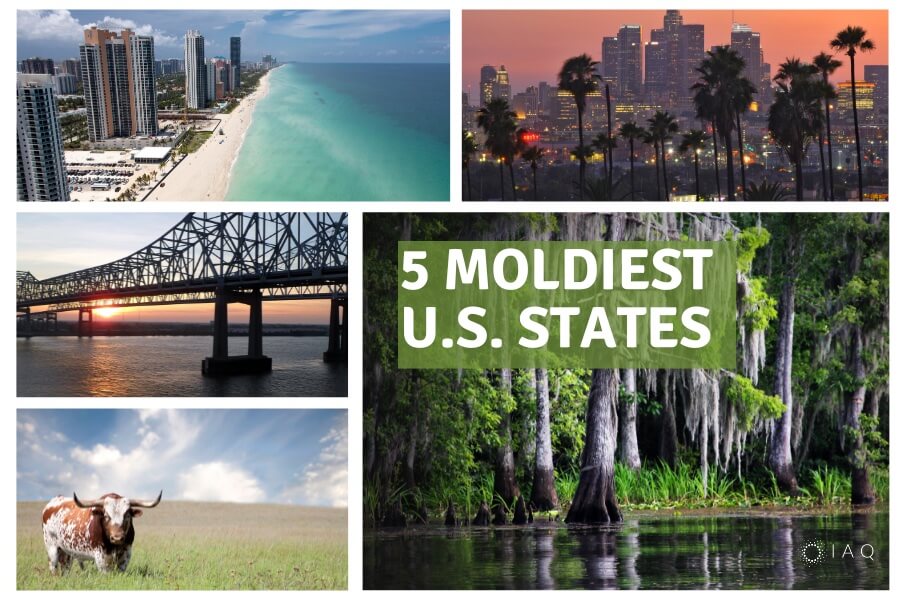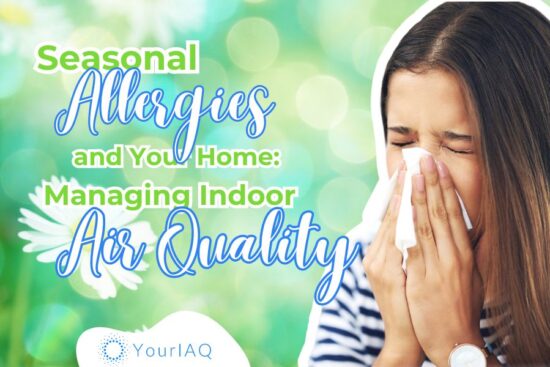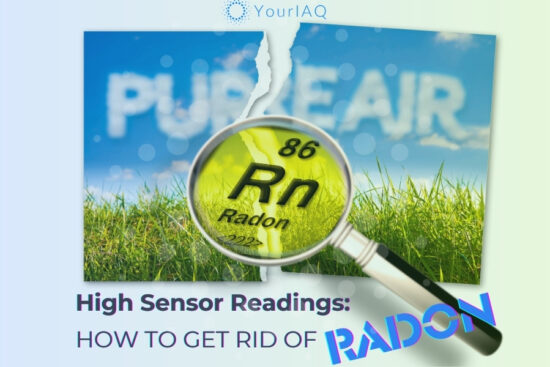
Mold can be found just about anywhere. It thrives in humidity, darkness, and warmth, spreading wherever these conditions are met and wreaking havoc on people’s health and homes.
When it grows in your home, you may experience infections, allergies, respiratory issues, and worse. Because mold releases spores into the air, there is risk of inhalation, making it a critical component of air quality. Prolonged exposure can lead to even more serious health impacts, including lung infections and neurological disorders.
See also: How to Detect Mold in the Air
5 Worst States for Mold
Who should be on high alert when it comes to mold growth? While it’s found throughout the country and the rest of the world, some parts of the U.S. are more mold-prone than others.
The restoration company Look Mold performed an analysis to answer this question using a combination of factors, including annual precipitation, average humidity, water damage insurance claims, construction materials usage, and residential lifestyle choices such as air conditioning usage. Here are the 5 worst states for mold based on their results:
5. California
While cities’ climates vary greatly across the state, California is known to have an arid climate with an average humidity of 61% and average temperature of 59.4°F. This dryness creates a false sense of security, which is often one of the main issues when it comes to mold growth. When not managed properly, mold can grow exponentially, creating lasting problems in your home.
4. Mississippi
Mississippi is one of the more humid states in the country, with 73.6% humidity and an average temperature of 63.4°F. Due in part to its low-lying geography and high potential for destructive storms, Mississippi has one of the highest average premiums on homeowners insurance. While it’s impossible to verify, Mississippi’s high proportion of low income residents may contribute to families deciding to deprioritize concerns such as mold growth, thus worsening the problem.
3. Texas
Texas has an average humidity of 64.9% and temperature of 64.8°F, both of which rank above the nation’s average. But it also has the highest number of water damage claims in the country. In 2014 alone, for example, State Farm managed 21,700 claims from Texas – 10,000 more than California, the runner-up!
2. Louisiana
Only half a percent less humid than Florida, Louisiana experiences its own mold challenges. It has an average humidity of 74% and temperature of 66.4°F, and it’s fourth in the nation in average annual precipitation. All of these factors lend themselves to high potential for mold growth.
1. Florida
Florida takes the #1 spot for moldiest state. With an average humidity of 74.5% and annual mean temperature of 70.7°F, all mold needs to grow is a nice dark corner or crevice. With the most coastline miles in the lower 48 states and a very low elevation, Florida also tends to have a high amount of water damage insurance claims, reflecting a lot of potential mold growth.
Further reading: How Much Mold Exposure Is Harmful?
States With Least Mold Problems
On the other hand, if you’re looking for the states with the least mold problems, the list shifts toward regions with lower humidity. Conditions such as high elevation and long cold spells can also contribute to lower mold growth. Here are the 5 states with the fewest mold problems.
1. Nevada
Nevada has the lowest annual precipitation in America with an average of around 10 inches per year. It’s largest city, Las Vegas, averages only around 4 inches annually.
2. Utah
Utah is the second or third driest state in the U.S. depending on the year, with about 11 inches of rain in an average year. It also has the benefit of high elevations. Most of the state’s population lives above 4,000 feet of altitude, which means plenty of freezing temperatures, in which mold doesn’t grow.
3. Arizona
Consistently one of the driest states in America, Arizona is covered with a lot of arid desert, where mold growth is rare. High elevations also contribute to fewer biological pollutants and allergens.
4. New Mexico
Another state with a mix of high elevations, long periods of sub-freezing temperatures, and low annual average precipitation. New Mexico tends to be a low risk state for anyone looking to avoid mold in their home.
5. Minnesota
Minnesota is unique on this list as it is not one of the drier states in the U.S., and doesn’t have high elevations. However, famously long, sub-arctic winters make it so that mold is unable to grow for nearly half the year.
Why Should I Care About Mold in my Home?
If you’re looking to reduce the number of dangerous pollutants in your home, mold prevention should be high on your list. However, mold can have negative impacts beyond your family’s health.
Mold growth puts your home’s structural integrity and property value at risk. Left untreated, it can weaken walls, doors, and ceilings, potentially even to the point of collapsing. This level of damage can permanently affect your home’s value and require advanced repairs and replacements to fix once it’s set in. It can also create the potential to cause physical harm.
Despite its prevalence, insurers don’t typically cover damage caused by mold. While truly accidental mold growth can be covered, insurers may deny coverage if homeowners failed to run a dehumidifier or the like.
Beyond this, already-devastating natural disasters like hurricanes can worsen mold problems, creating lasting issues throughout people’s homes and possessions. Many of these problems come from resulting flooding, yet standard homeowners insurance policies don’t cover damage caused by floods.
How Monitoring Air Can Help Prevent Mold
Obviously, mold can be a problem no matter where you live, so it’s always something to be aware of. Catching the issue before it spirals out of control is essential. Sensors like IAQ can detect particulate matter and alert you of potential danger so you can take control of your health and your home’s structure.
Be aware and breathe easy!







